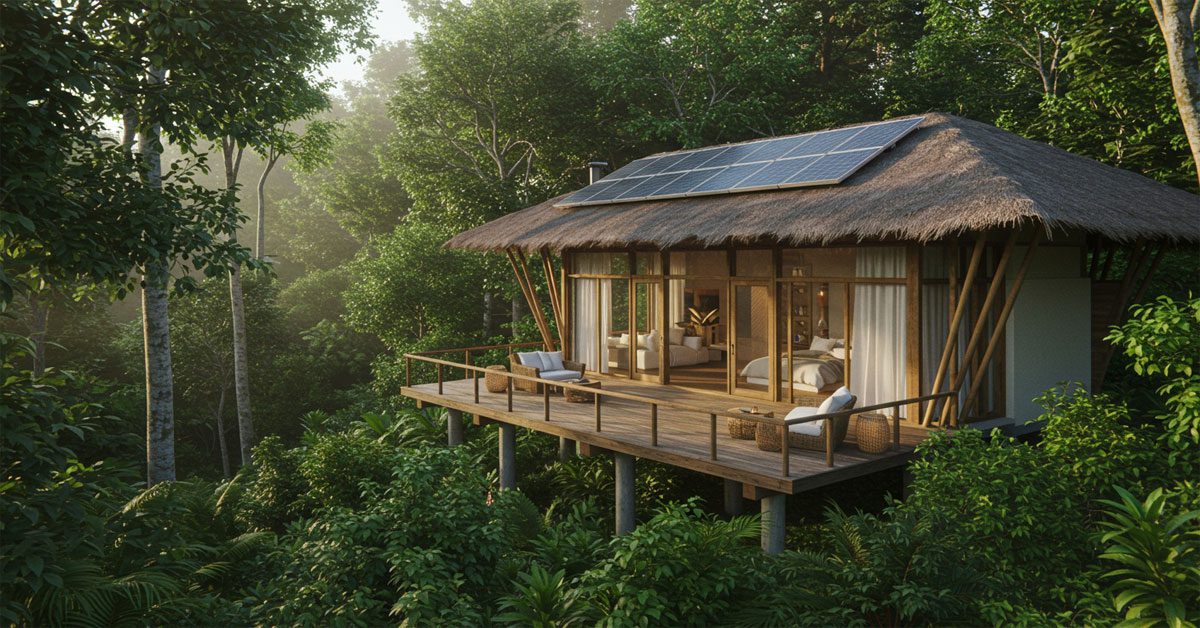Eco-Friendly Hospitality
In today’s travel landscape, being eco-friendly isn’t just a marketing buzzword—it’s a necessity. Travelers, especially younger generations, are actively seeking hotels that align with their environmental values. According to recent surveys, more than 70% of global travelers say they prefer accommodations that adopt sustainable practices. For hotels, this isn’t just an opportunity—it’s a competitive advantage.
Eco-friendly hospitality means operating a hotel in a way that minimizes environmental impact while still providing comfort and luxury to guests. It’s about reducing waste, conserving resources, sourcing sustainably, and creating a healthier planet without compromising the guest experience.
From rooftop solar panels to biodegradable toiletries, the possibilities are endless.
But the key to success is intentionality. Hotels need to go beyond surface-level “greenwashing” and actually embed sustainability into their business model. Guests are savvy; they can tell when an eco-friendly claim is authentic. The reward for doing it right? Increased customer loyalty, reduced operational costs, and a stronger brand reputation.
Why Sustainability Matters in the Hospitality Industry
Hotels are resource-intensive by nature. Think about it—lights are on 24/7, linens are washed daily, air conditioning runs constantly, and countless plastic amenities are provided to guests. This constant cycle of consumption takes a toll on the environment.
Adopting sustainable practices can help mitigate these effects. For example, switching to renewable energy reduces carbon emissions, and implementing water-saving measures can conserve thousands of gallons annually. Plus, sustainability can save hotels money in the long term—less energy and water use means lower utility bills.
Growing Demand for Green Travel
Green travel is no longer a niche market. Platforms like Booking.com and Airbnb have introduced eco-friendly filters so travelers can specifically search for green accommodations. Many travelers are willing to pay more for hotels that are committed to sustainability. This shift in consumer demand is a clear signal: hotels that fail to adapt risk being left behind.
If you’re looking for inspiration, several of our partner eco-lodges are already setting the gold standard for sustainable hospitality. From the Green Leaf Lodge, which runs entirely on solar energy, to Riverstone Eco Retreat, where rainwater harvesting meets organic farm-to-table dining, these properties prove that luxury and sustainability can go hand in hand. Guests can immerse themselves in nature while knowing their stay supports conservation and local communities. You can explore and book these unforgettable eco-friendly getaways here.
Step 1 – Conduct a Sustainability Audit
Before a hotel can become more eco-friendly, it must first understand its current environmental footprint. This is where a sustainability audit comes in. An audit examines every aspect of hotel operations—energy use, water consumption, waste management, and sourcing policies.
Think of it as a health check-up for your property. You can’t fix what you don’t measure. The results of this audit will provide a clear roadmap for improvement.
Evaluating Current Energy, Water, and Waste Usage
To start, gather utility bills for the past year to determine baseline energy and water usage. Track waste generation—both general trash and recyclables. Identify peak usage times and areas of inefficiency, like outdated appliances or poorly insulated rooms.
Technology can help here. Smart meters and sensors can provide real-time data on energy and water consumption, making it easier to pinpoint problem areas.
Identifying Key Improvement Areas
After collecting the data, categorize findings into “quick wins” and “long-term investments.” Quick wins might include switching to LED bulbs or adjusting thermostat settings, while long-term investments could involve installing solar panels or upgrading to energy-efficient HVAC systems.
This audit should be repeated annually to track progress and keep sustainability goals on target.
Step 2 – Switch to Renewable Energy Sources
One of the most impactful ways to reduce a hotel’s carbon footprint is to transition to renewable energy. This can involve installing on-site solar panels, purchasing renewable energy credits, or partnering with local green energy providers.
Solar Panels and Wind Energy Options
Solar panels can be installed on rooftops, carports, or open land near the property. Wind turbines are another option for hotels in windy regions. While these require upfront investment, government incentives and long-term energy savings can make them financially viable.
Partnering with Green Energy Providers
If on-site generation isn’t feasible, hotels can still go green by purchasing power from certified renewable energy suppliers. This allows you to tap into clean energy without the infrastructure costs.
Transitioning to renewable energy not only lowers operational emissions but also sends a strong message to eco-conscious travelers that your commitment is serious.
Step 3 – Implement Water Conservation Practices
Water scarcity is a growing global concern, and hotels consume a lot of it. Reducing water use is not only environmentally responsible but also cost-effective.
Installing Low-Flow Fixtures and Efficient Plumbing
Low-flow showerheads, faucets, and dual-flush toilets can significantly cut water use without compromising guest comfort. In many cases, guests won’t even notice the difference.
Rainwater Harvesting and Greywater Recycling
Hotels can collect rainwater for landscaping or cleaning purposes. Greywater systems can recycle lightly used water from sinks and showers for use in toilet flushing and irrigation.
When implemented well, these measures can cut water usage by up to 40%, making them both eco-friendly and budget-friendly.
Step 4 – Reduce Single-Use Plastics
Single-use plastics are one of the biggest environmental challenges in hospitality. From bottled water to shampoo bottles, hotels generate significant plastic waste.
Alternatives to Plastic Bottles and Straws
Replace plastic water bottles with glass or refillable dispensers. Offer paper straws or biodegradable alternatives. For amenities, provide larger refillable dispensers instead of small single-use bottles.
Encouraging Guests to Bring Reusable Items
Include a sustainability section in booking confirmations encouraging guests to bring their own reusable water bottles and shopping bags. Provide incentives, like discounts or loyalty points, for guests who opt out of single-use items.
Small changes like these add up quickly—especially when multiplied across hundreds or thousands of guests.
Step 5 – Optimize Waste Management and Recycling
Hotels produce large amounts of waste daily—from food scraps to packaging materials. Having an effective waste management plan is essential.
Establishing a Comprehensive Recycling Program
Place clearly labeled recycling bins in guest rooms, public areas, and staff zones. Partner with local recycling facilities to ensure collected materials are processed correctly.
Composting Food Waste for Sustainability
Food waste is a major problem in hotels, especially those with on-site restaurants or buffets. Composting turns food scraps into nutrient-rich soil for landscaping, reducing landfill waste and creating a circular economy within the hotel’s operations.
By making recycling and composting easy and accessible, hotels can drastically cut their environmental footprint.
Step 6 – Invest in Energy-Efficient Appliances and Lighting
Energy-efficient upgrades are one of the fastest ways to cut operational costs while reducing environmental impact. Many hotels still use outdated equipment that consumes more energy than necessary, leading to higher bills and greater emissions.
LED Lighting and Smart Energy Systems
Switching from incandescent or fluorescent bulbs to LED lighting can reduce energy consumption by up to 80%. LEDs also last significantly longer, meaning fewer replacements and less waste.
Pair this with smart energy management systems that automatically adjust lighting and temperature based on occupancy. For example, motion sensors in hallways and public spaces ensure lights aren’t left on unnecessarily, while smart thermostats can optimize heating and cooling without compromising guest comfort.
Eco-Certified Appliances for Reduced Consumption
When upgrading appliances—whether it’s laundry machines, refrigerators, or HVAC units—look for eco-certified models that meet ENERGY STAR or equivalent standards. These appliances use less electricity and water while delivering the same performance.
Even kitchen equipment in hotel restaurants can be upgraded to energy-efficient models, reducing operational costs and supporting sustainability goals.
Step 7 – Source Local and Sustainable Products
The supply chain plays a massive role in a hotel’s environmental footprint. By sourcing products locally and from sustainable producers, hotels can reduce emissions from transportation and support regional economies.
Farm-to-Table Restaurant Practices
If your hotel has a restaurant, work with nearby farms and suppliers to source fresh, organic ingredients. This not only reduces food miles but also enhances the dining experience with fresher flavors. Highlighting local specialties on the menu can also be a unique selling point for guests who want an authentic experience.
Eco-Friendly Toiletries and Linens
Replace traditional toiletries with biodegradable or refillable options from eco-conscious brands. Choose linens made from organic cotton or bamboo, which require fewer pesticides and less water to produce.
Sourcing responsibly ensures that your commitment to sustainability extends beyond just hotel operations—it’s embedded in everything you offer.
Step 8 – Promote Green Transportation Options
Transportation is one of the largest contributors to a traveler’s carbon footprint. Hotels can help offset this by encouraging and facilitating eco-friendly transport methods.
Electric Vehicle Charging Stations
Installing EV charging points can attract eco-conscious travelers who drive electric cars. This small investment can significantly increase guest satisfaction and position your hotel as forward-thinking in sustainability.
Bicycles and Shuttle Services for Guests
Provide complimentary bicycles for guests to explore the local area. Offer electric shuttle services to nearby attractions or public transportation hubs. This not only reduces the environmental impact but also adds to the guest experience by making travel more convenient.
By integrating these options into your hotel’s offerings, you actively help guests make greener choices without sacrificing comfort or convenience.
Step 9 – Engage and Train Staff on Sustainability
A hotel’s sustainability efforts are only as strong as its team. Staff members interact with guests daily and play a key role in ensuring eco-friendly practices are followed consistently.
Employee Workshops and Incentives
Host regular workshops to educate employees on sustainability goals, best practices, and the role they play in achieving them. Consider incentives for staff who contribute innovative ideas or consistently uphold green policies.
Creating a Culture of Eco-Responsibility
Sustainability should become part of the hotel’s culture, not just a checklist. Encourage staff to lead by example, from switching off unused lights to promoting recycling initiatives with guests. When employees feel ownership over these efforts, sustainability becomes a natural part of daily operations.
Step 10 – Educate and Involve Guests
Guests are more likely to support your sustainability initiatives when they understand their impact and feel involved.
Eco-Friendly Activities and Tours
Offer guided nature walks, eco-tours, or workshops on sustainable cooking and gardening. This not only educates guests but also creates memorable experiences that align with your green brand.
Rewarding Guests for Sustainable Choices
Provide incentives like discounts, free drinks, or loyalty points for guests who reuse towels, avoid single-use plastics, or opt for housekeeping every other day instead of daily.
When sustainability becomes a collaborative effort between hotel and guest, the results are more impactful and long-lasting.
Measuring and Communicating Your Sustainability Efforts
Tracking and sharing your progress keeps you accountable and strengthens your brand’s credibility.
Tracking Progress with Eco-Certifications
Pursue recognized certifications like LEED, Green Key, or EarthCheck to validate your efforts. These not only set measurable benchmarks but also enhance your marketing appeal.
Marketing Your Green Credentials
Use your website, social media, and booking platforms to highlight your green initiatives. Share data, stories, and testimonials that show your commitment in action. Guests appreciate transparency, and showcasing your achievements can set you apart from competitors.
Conclusion – The Future of Green Hospitality
The shift toward sustainable travel isn’t slowing down—it’s accelerating. Hotels that invest in eco-friendly practices today will be the industry leaders of tomorrow. By integrating these ten steps into your operations, you’re not only protecting the planet but also enhancing guest satisfaction, building brand loyalty, and securing a more profitable future.
Sustainability in hospitality is a win-win scenario: better for the environment, better for business, and better for the guest experience. The time to start is now.






